Things to do in Yangon
The shining jewel of Yangon's many attractions is Shwedagon Pagoda, the golden temple visible throughout the city and an iconic sight emblematic of the country and its strong Buddhist influence. Other major attractions include the 2,200-year-old Sule Pagoda, Little India and Chinatown, and the vibrant night markets including Bogyoke Aung San Market, which is also arguably the best place to exchange money. Inle Lake is lined with gardens and luxurious villas, providing a cooling distraction at sunset, when locals and visitors can enjoy the views. Other popular attractions in Yangon include the Taukkyan War Cemetery, a beautifully maintained graveyard and memorial to those who died fighting the Japanese is World War II, the Musmeah Yeshua Synagogue and Old Jewish Cemetery, and the Kyaikto, or Golden Rock, which is a glorious landmark.
The city has seen a big increase in tourists recently, and infrastructure is improving to accommodate visitors. Hopefully Yangon won't lose its charm and off-the-beaten track appeal as it becomes more popular.
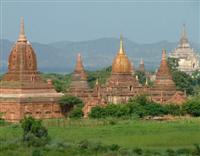
Bagan
Bagan is an ancient city dating back to the 9th century that was home to the first kingdom of a unified Myanmar. A seemingly impossible collection of thousands of temples and monum…
Bagan
Bagan is an ancient city dating back to the 9th century that was home to the first kingdom of a unified Myanmar. A seemingly impossible collection of thousands of temples and monuments scattered over a vast plain, the buildings range in condition from ruined to resplendent, although many retain the power and majesty their devout designers intended. Most of the structures were built between the 11th and 12th centuries, when Bagan was the capital of the First Burmese Empire. Regrettably, many temples have suffered under the government's poor attempts at restoration, but others have been well preserved by organisations like UNESCO.
The temples can best be viewed via bicycle, which allows for independent exploration as bike trails link all the temples. This attraction still feels relatively undiscovered and allows visitors to feel that they are the only ones exploring a temple. Each is thoroughly unique so visitors can spend days exploring and remain enthralled. Sunset is prime time in Bagan, as locals and visitors alike head for the highest temples to enjoy the magnificent sunsets over the stupa-dotted plain. Another popular way of seeing the temples is from the air, in a hot air balloon.
Shwedagon Pagoda
Shwedagon Pagoda is Myanmar's most famous sight, an iconic landmark that stands as a highlight for any visitor to the region. The stupa is covered in gold plates weighing an estima…
Shwedagon Pagoda
Shwedagon Pagoda is Myanmar's most famous sight, an iconic landmark that stands as a highlight for any visitor to the region. The stupa is covered in gold plates weighing an estimated 52 metric tons and topped with a 76-carat diamond, as well as being covered by many other jewels. The temple was built between the 6th and 10th centuries, although the site atop Singuttara Hill has been considered holy for over 2,500 years.
Also known as the Golden Temple, Shwedagon is the most sacred site for Burmese Buddhists, and is a daily focus for worship. Relics of the Buddha are said to be housed in the stupa, along with many other historical artefacts and great treasures. There are stairways at the north, south, east, and west and you can ascend using any of these, or the elevator if you want to skip the climb. The southern entrance is the most used because it rises out of the city; and the eastern stairway, although damaged by the British long ago, is popular because it leads down to the bazaars, making it a good exit point for prospective shoppers.
Shwedagon is a place of worship, prayer and meditation, and it is important to act with respect and keep noise levels down. Dress conservatively, with long pants and sleeves, and remove your shoes when entering the complex. Be discreet when using your camera. Sunset and sunrise are the most powerful times to visit the stupa.
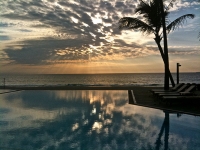
Ngwe Saung
Ngwe Saung is one of the most laid-back places in the country, where visitors can unwind along a gorgeous, 10-mile (15km) stretch of palm-lined beach. A small touristy village has …
Ngwe Saung
Ngwe Saung is one of the most laid-back places in the country, where visitors can unwind along a gorgeous, 10-mile (15km) stretch of palm-lined beach. A small touristy village has materialised on the beach's parallel road, with craft stalls selling cheap trinkets and delicious seafood. At low tide a small island appears which you can walk to and around.
Package tours can arrange transport and hotel, but the beach is easy to get to from Yangon without pre-arrangement. The bus station next to Yangon's train station sells tickets for the five to six hour ride to the lovely coast. However, passengers should be wary of being passed off to smaller buses and charged again. Ngwe Saung is a popular excursion from Yangon, and many choose to stay one or two nights to enjoy the lovely beaches.
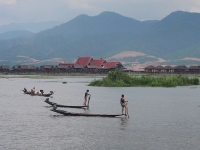
Lake Inle
Located at the base of steep green hills, Inle Lake is remarkable because of its inhabitants: around 70 000 people who live on and around the lake. Whole villages rest on stilts su…
Lake Inle
Located at the base of steep green hills, Inle Lake is remarkable because of its inhabitants: around 70 000 people who live on and around the lake. Whole villages rest on stilts surrounded by water, rather like a bamboo and teak Venice, where men steer rowing boats through water roads. The men have adapted a unique way to row, wrapping one leg around an oar and standing with the other, which frees their hands to fish at the same time.
Tourists can hire a boat and guide to lead them through floating markets and workshops making silks, cigars (cheroots), and jewellery. An impressive wooden temple on the water is also open to visitors; bizarrely, the monks at the temple are famous for having trained cats to jump through hoops and perform tricks.
Visitors first arrive in the town of Nyaungshwe to a host of riverside guesthouses and restaurants. Boat hire can be done through hotels or independently at the town's river. Expensive hotels on the lake can be booked in advance but more rustic accommodation can usually be found without pre-planning. Depending on the season the town can flood, making the concept of living on water a little more practical than it first seemed.
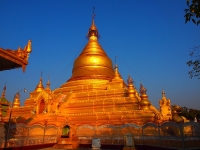
Mandalay
Mandalay is Myanmar's second-largest city and the former royal capital of the Burmese kingdom. A good place to start a visit is to hike up the 780-foot (240m) stairwell to the top …
Mandalay
Mandalay is Myanmar's second-largest city and the former royal capital of the Burmese kingdom. A good place to start a visit is to hike up the 780-foot (240m) stairwell to the top of Mandalay Hill, a holy site with an ornately decorated temple with a Buddha statue overlooking the former capital city and far-reaching flatlands. Dominating the city's centre are the 150-year-old palace grounds of King Mindon and King Thibaw, with an adjacent temple and surrounding moat. For local travellers the Mahamuni Buddha is one of the most important pilgrimage sites for Buddhists in Myanmar.
Aside from sightseeing, shopping is Mandalay's major pastime. A jewel market, where visitors can watch craftsmen shape gems, is worth a visit. Crafts such as monk's umbrellas, gold leaf, ornate furniture, and lacquer-ware are made and sold within the city. Motorbike taxis are available, as are trishaws, which are traditionally used in rural Myanmar.
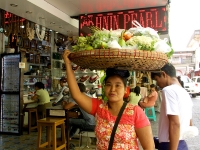
Bogyoke Aung San Market
The Bogyoke Aung San Market is the perfect place for tourists to start their visit to Myanmar, not only because it is the best place in town to convert foreign currency, but becaus
Bogyoke Aung San Market
The Bogyoke Aung San Market is the perfect place for tourists to start their visit to Myanmar, not only because it is the best place in town to convert foreign currency, but because it gives an idea of what the country has in store.
In the past, the official exchange rate of the Myanmar kyat was kept artificially strong by government-set rates, creating a large black market trade in the currency at a much better price for tourists. The black market has endured and the best place to change currency is in the central jewellery section of the market. To maximise the rates it is best to ask several different vendors and bargain hard. Be careful to count your money and do the exchange math yourself. Exchanging currency on the black market is risky, but many travellers go this route.
Once you have converted money the market is a great place to buy crafts, artwork, jewellery or antiques. Popular souvenirs include Burmese cigars, and old Burmese currency, some of which was issued in the curious but numerologically auspicious denominations of 35, 75 and 90 kyat notes. Bogyoke Aung San Market is open daily from about 9am to 5pm and is centrally located in downtown Yangon. Locals will be happy to direct you if you get lost.



